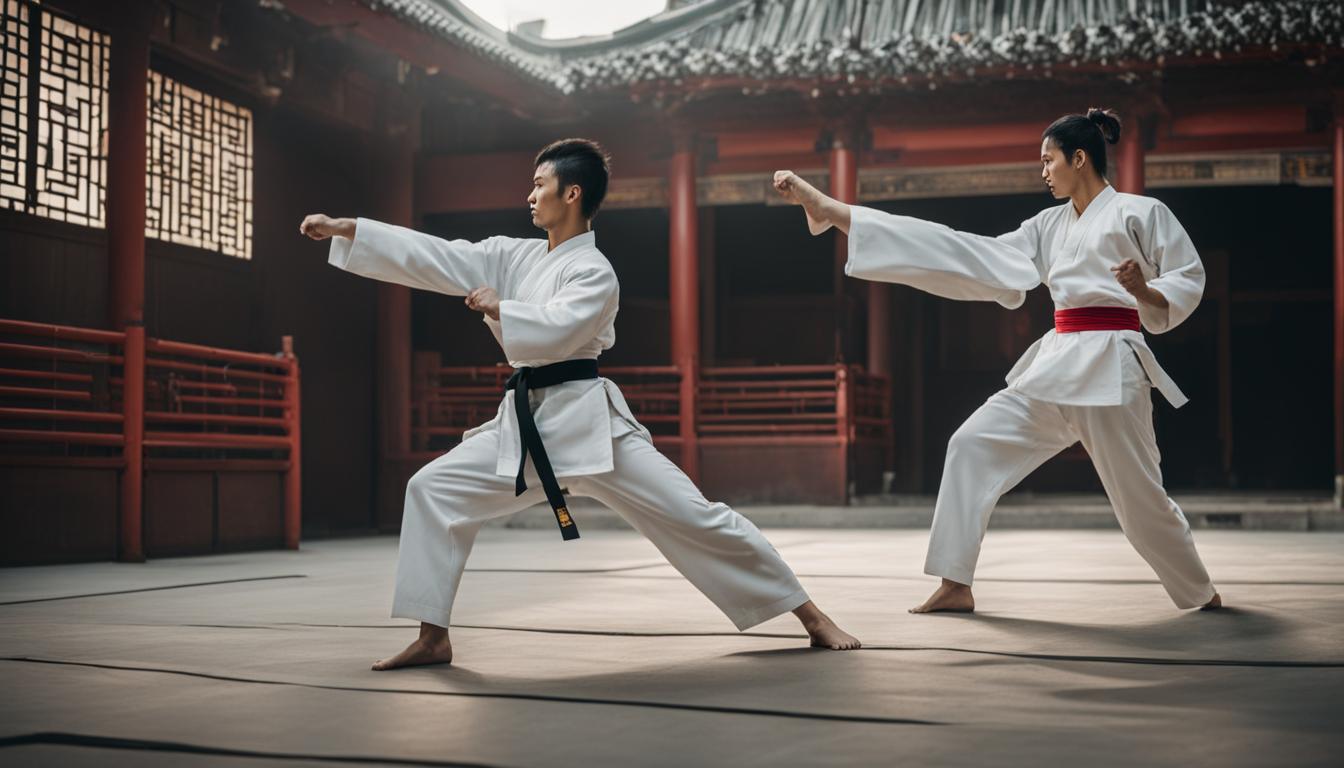When it comes to martial arts, there are few styles as revered and respected as kung fu and taekwondo. Both of these ancient practices have their own unique strengths and philosophies. But which martial art is right for you? In this article, I will compare kung fu and taekwondo, exploring their techniques, training methods, and self-defense applications, to help you make an informed decision.
Key Takeaways
- Kung fu and taekwondo are both highly respected martial arts with distinct differences.
- Kung fu originates from China and emphasizes fluid movements and self-defense applications.
- Taekwondo is a Korean martial art that focuses on elaborate and powerful kicks.
- The techniques and training methods in kung fu and taekwondo cater to different preferences and goals.
- Both martial arts offer physical fitness, mental discipline, and self-defense skills.
The Origins and Styles of Kung Fu
Kung fu, originating from China, encompasses a wide range of fighting styles and traditions. It is often associated with Shaolin Kung Fu, which was developed and taught by the Buddhist monks of the Shaolin Temple. Other popular styles of kung fu include Wing Chun, Praying Mantis, and Tai Chi.
Kung fu practitioners focus on fluid and continuous movements, often imitating the movements of animals. Some schools of kung fu also incorporate weapon training, such as staffs, swords, and nunchaku.
| Style | Origin | Characteristics |
|---|---|---|
| Shaolin Kung Fu | Developed by the Shaolin monks | Emphasis on physical and mental discipline |
| Wing Chun | Developed in the late Qing dynasty | Close-quarters combat and quick strikes |
| Praying Mantis | Said to be influenced by the mantis insect | Fast and aggressive strikes |
| Tai Chi | Rooted in Taoist philosophy | Slow and meditative movements |
Kung Fu Weapons Training
Kung fu schools often incorporate weapon training to enhance the skills of its practitioners. Here are some common weapons used in kung fu:
- Staffs
- Swords
- Nunchaku
Weapon forms and training add an additional layer of complexity and skill to the practice of kung fu.
Understanding Taekwondo and Its Philosophy
Taekwondo, Korea’s national sport, is a relatively modern martial art that combines various Korean fighting techniques. It places a strong emphasis on kicks, with an aim to strike opponents above the waist. Taekwondo can be categorized into two main styles: the International Taekwondo Federation (ITF) style and the World Taekwondo (WT) style.
The ITF style of Taekwondo focuses on self-defense and comprehensive fighting techniques. It incorporates a wide range of strikes, kicks, and grappling moves to prepare practitioners for real-life combat situations. The ITF style emphasizes the development of practical self-defense skills and a deep understanding of the art’s origins.
The WT style of Taekwondo prioritizes high-paced sparring and competitive techniques. It is commonly seen in Olympic competitions and showcases the dynamic kicking techniques that Taekwondo is renowned for. The WT style focuses on agility, speed, and precision in executing powerful kicks and scoring points in sparring matches.
While Taekwondo primarily utilizes the legs as the main weapon, some schools also offer weapon training, although it is less common than in kung fu. Weapon training in Taekwondo usually involves the use of traditional Korean weapons such as the jukdo (bamboo sword) or the jindo (nunchaku). However, the emphasis in Taekwondo is predominantly on mastering empty-hand techniques and the art of kicking.
The Philosophy of Taekwondo
Alongside its physical techniques, Taekwondo also places a significant emphasis on the development of mental discipline and philosophy. Central to Taekwondo’s philosophy is the five tenets of courtesy, integrity, perseverance, self-control, and indomitable spirit. These values guide practitioners on and off the mat, fostering personal growth and character development.
I believe that Taekwondo is not just a martial art but a way of life. It provides me with the discipline and focus I need to overcome challenges and strive for excellence in all aspects of my life.
When practicing Taekwondo, students are encouraged to cultivate self-awareness, respect, and humility. Through meditation, visualization, and regular training, practitioners develop mental strength, self-confidence, and the ability to remain calm in challenging situations.
Overall, Taekwondo offers a holistic approach to martial arts training. It combines physical fitness, practical self-defense skills, and the development of mental discipline and philosophy. Whether one chooses the ITF or WT style, Taekwondo provides an opportunity for personal growth, inner strength, and a connection to Korea’s rich martial arts heritage.
Comparing Techniques and Training Methods
The techniques and training methods in kung fu and taekwondo differ significantly. Kung fu offers a diverse range of techniques that include strikes, kicks, and grappling, providing a comprehensive approach to self-defense. Training in kung fu involves fluid and continuous movements, which help develop speed, power, and agility.
On the other hand, taekwondo specializes in powerful and acrobatic kicks, with less emphasis on grappling techniques. Training in taekwondo focuses on flexibility, strength, and precise kicking techniques. Both martial arts offer physical fitness, mental discipline, and self-defense skills. However, their techniques and training methods cater to different preferences and goals.
Kung fu techniques encompass a wide variety of strikes, kicks, and grappling techniques, making it a well-rounded martial art for self-defense. Training in kung fu involves fluid movements and develops speed, power, and agility.
Taekwondo techniques primarily focus on powerful and acrobatic kicks. Training in taekwondo emphasizes flexibility, strength, and precise kicking techniques.
| Kung Fu | Taekwondo | |
|---|---|---|
| Techniques | Wide range of strikes, kicks, and grappling techniques | Emphasis on powerful and acrobatic kicks |
| Training | Fluid movements, speed, power, and agility | Flexibility, strength, and precise kicking techniques |
| Self-Defense | Well-rounded approach to self-defense | Focus on striking techniques and kicks for self-defense |
While kung fu provides a more well-rounded approach to self-defense with its range of techniques, taekwondo’s focus on powerful kicks can be an advantage in certain situations. The choice between the two depends on individual preferences, goals, and what resonates with the practitioner. Trying out both styles and consulting with experienced instructors can help in making an informed decision.
Philosophy and Mental Discipline
Both kung fu and taekwondo incorporate philosophy and mental discipline into their training.
“The path of the warrior is not solely about physical strength, but also about cultivating the mind and spirit.” – Master Li
Kung fu, often influenced by Buddhism and Taoism, emphasizes the harmony and balance between the practitioner and the universe. It promotes self-awareness, self-control, and personal growth through meditation and introspection. In kung fu philosophy, the focus is on finding balance within oneself and maintaining a calm and peaceful mind, even in the face of adversity. This philosophy is reflected in the fluid and graceful movements of kung fu techniques.
Taekwondo also has its philosophy, which emphasizes the development of mental strength, respect, and self-confidence. The mental discipline aspect of taekwondo training aims to cultivate discipline, focus, and perseverance. Taekwondo philosophy encourages practitioners to cultivate self-discipline and respect for oneself and others. This mental discipline is essential for executing precise and powerful kicks in taekwondo.
Both martial arts aim to instill discipline, focus, and a sense of personal growth in their practitioners. However, their philosophical origins and teachings may vary. Ultimately, the philosophy and mental discipline aspects of kung fu and taekwondo contribute to the holistic development of practitioners, nurturing not only their physical abilities but also their mental and emotional well-being.
| Kung Fu Philosophy and Mental Discipline | Taekwondo Philosophy and Mental Discipline |
|---|---|
| Promotes harmony and balance between the practitioner and the universe | Emphasizes mental strength, self-confidence, and respect |
| Focuses on self-awareness, self-control, and personal growth | Cultivates discipline, focus, and perseverance |
| Influenced by Buddhism and Taoism | Has its unique Korean philosophy |
| Encourages meditation and introspection | Develops mental discipline through training and practice |
Weapons Training in Kung Fu and Taekwondo
In martial arts, weapons training adds an extra layer of skill and complexity to one’s training regimen. While kung fu is known for its extensive weapons training, taekwondo also incorporates some weapon forms and training, although to a lesser extent.
In kung fu, practitioners have the opportunity to learn a variety of traditional weapons, such as staffs, swords, and chains. The practice of weapon forms in kung fu allows practitioners to explore different techniques and develop a deeper understanding of the martial art’s heritage.
On the other hand, taekwondo primarily focuses on empty-hand techniques, as it is a discipline that centers around powerful and precise kicks. However, some taekwondo schools, particularly those in the United States, offer weapon training in staffs, nunchucks, and other traditional weapons as well.
It’s important to note that weapon training in taekwondo is relatively rare and not as emphasized as it is in kung fu. Taekwondo’s focus remains on mastering empty-hand techniques, with weapon training serving as more of an additional option rather than a core component of the martial art.
Ultimately, the decision to pursue weapons training depends on individual preferences and goals. Both kung fu and taekwondo offer unique opportunities to explore weapons, but kung fu provides a more extensive and traditional approach to this aspect of martial arts training.
Comparison of Weapons Training in Kung Fu and Taekwondo
| Kung Fu Weapons Training | Taekwondo Weapons Training |
|---|---|
| Emphasizes a wide variety of traditional weapons, such as staffs, swords, and chains | Offers limited weapon training, including staffs and nunchucks, particularly in the United States |
| Incorporates weapon forms and training as an integral part of the martial art | Weapon training is rarer and not as emphasized; primarily focuses on empty-hand techniques |
| Provides a deeper exploration of different techniques and cultural heritage | Weapon training serves as an additional option and less of a core component |
Conclusion
In conclusion, both kung fu and taekwondo are respected martial arts that offer physical fitness, mental discipline, and self-defense skills. The choice between the two ultimately depends on personal preferences, goals, and what resonates with the individual.
Kung fu, with its diverse styles and emphasis on fluid movements, may be more suitable for those seeking a more well-rounded approach to self-defense and exploration of different techniques. It allows practitioners to learn a variety of strikes, kicks, and grappling techniques, providing a comprehensive skillset for combat situations.
Taekwondo, on the other hand, is known for its powerful and acrobatic kicks. It appeals to those interested in mastering precise and dynamic kicking techniques, perfecting their form, and executing high-paced movements in sparring and competition.
To make an informed decision, it is recommended to try out classes and schools from both disciplines. This practical experience will allow individuals to assess which martial art aligns best with their personal preferences, goals, and physical capabilities. Ultimately, the choice between kung fu and taekwondo should be based on what resonates with the individual and the kind of training experience they seek.



